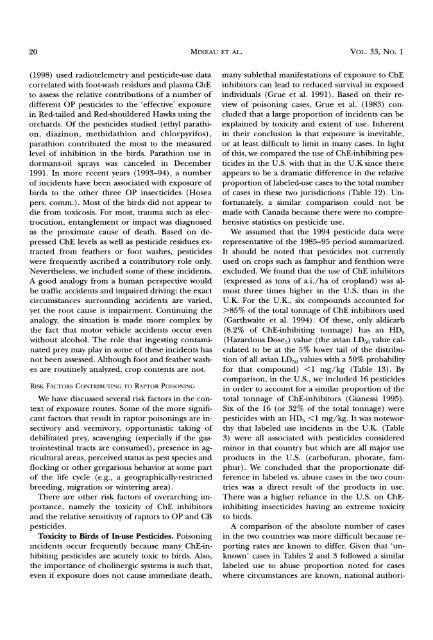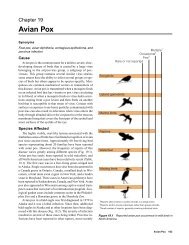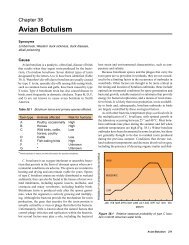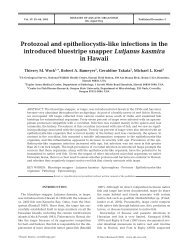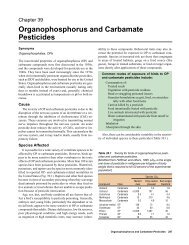poisoning of raptors with organophosphorus and carbamate ...
poisoning of raptors with organophosphorus and carbamate ...
poisoning of raptors with organophosphorus and carbamate ...
You also want an ePaper? Increase the reach of your titles
YUMPU automatically turns print PDFs into web optimized ePapers that Google loves.
20 M•NE^U ET AL. VOL. 33, NO. 1<br />
(1998) used radiotelemetry <strong>and</strong> pesticide-use data<br />
correlated <strong>with</strong> foot-wash residues <strong>and</strong> plasma ChE<br />
to assess the relative contributions <strong>of</strong> a number <strong>of</strong><br />
different OP pesticides to the 'effective' exposure<br />
in Red-tailed <strong>and</strong> Red-shouldered Hawks using the<br />
orchards. Of the pesticides studied (ethyl parathion,<br />
diazinon, methidathion <strong>and</strong> chlorpyrifos),<br />
parathion contributed the most to the measured<br />
level <strong>of</strong> inhibition in the birds. Parathion use in<br />
breeding, migration or wintering area).<br />
There are other risk factors <strong>of</strong> overarching importance,<br />
namely the toxicity <strong>of</strong> ChE inhibitors<br />
<strong>and</strong> the relative sensitivity <strong>of</strong> <strong>raptors</strong> to OP <strong>and</strong> CB<br />
pesticides.<br />
Toxicity to Birds <strong>of</strong> In-use Pesticides. Poisoning<br />
incidents occur frequently because many ChEdnhibiting<br />
pesticides are acutely toxic to birds. Also,<br />
the importance <strong>of</strong> cholinergic systems is such that,<br />
even if exposure does not cause immediate death,<br />
many sublethal manifestations <strong>of</strong> exposure to ChE<br />
inhibitors can lead to reduced survival in exposed<br />
individuals (Grue et al. 1991). Based on their review<br />
<strong>of</strong> <strong>poisoning</strong> cases, Grue et al. (1983) concluded<br />
that a large proportion <strong>of</strong> incidents can be<br />
explained by toxicity <strong>and</strong> extent <strong>of</strong> use. Inherent<br />
in their conclusion is that exposure is inevitable,<br />
or at least difficult to limit in many cases. In light<br />
<strong>of</strong> this, we compared the use <strong>of</strong> ChE-inhibiting pesticides<br />
in the U.S. <strong>with</strong> that in the U.K since there<br />
dormant-oil sprays was canceled in December<br />
1991. In more recent years (1993-94), a number<br />
<strong>of</strong> incidents have been associated <strong>with</strong> exposure <strong>of</strong><br />
birds to the other three OP insecticides (Hosea<br />
pers. comm.). Most <strong>of</strong> the birds did not appear to<br />
die from toxicosis. For most, trauma such as electrocution,<br />
entanglement or impact was diagnosed<br />
as the proximate cause <strong>of</strong> death. Based on depressed<br />
ChE levels as well as pesticide residues extracted<br />
from feathers or foot washes, pesticides<br />
were frequently ascribed a contributory role only.<br />
appears to be a dramatic difference in the relative<br />
proportion <strong>of</strong> labeled-use cases to the total number<br />
<strong>of</strong> cases in these two jurisdictions (Table 12). Unfortunately,<br />
a similar comparison could not be<br />
made <strong>with</strong> Canada because there were no comprehensive<br />
statistics on pesticide use.<br />
We assumed that the 1994 pesticide data were<br />
representative <strong>of</strong> the 1985-95 period summarized.<br />
It should be noted that pesticides not currently<br />
used on crops such as famphur <strong>and</strong> fenthion were<br />
Nevertheless, we included some <strong>of</strong> these incidents. excluded. We found that the use <strong>of</strong> ChE inhibitors<br />
A good analogy from a human perspective would<br />
be traffic accidents <strong>and</strong> impaired driving: the exact<br />
circumstances surrounding accidents are varied,<br />
yet the root cause is impairment. Continuing the<br />
analogy, the situation is made more complex by<br />
(expressed as tons <strong>of</strong> a.i./ha <strong>of</strong> cropl<strong>and</strong>) was almost<br />
three times higher in the U.S. than in the<br />
U.K. For the U.K., six compounds accounted for<br />
>85% <strong>of</strong> the total tonnage <strong>of</strong> ChE inhibitors used<br />
(Garthwaite et al. 1994). Of these, only aldicarb<br />
the fact that motor vehicle accidents occur even (8.2% <strong>of</strong> ChE-inhibiting tonnage) has an HD5<br />
<strong>with</strong>out alcohol. The role that ingesting contaminated<br />
prey may play in some <strong>of</strong> these incidents has<br />
not been assessed. Although foot <strong>and</strong> feather washes<br />
are routinely analyzed, crop contents are not.<br />
(Hazardous Doses) value (the avian LD50 value calculated<br />
to be at the 5% lower tail <strong>of</strong> the distribution<br />
<strong>of</strong> all avian LD50 values <strong>with</strong> a 50% probability<br />
for that compound)


